Almost three months ago I authored my first post on Steemit on the Greek painter El Greco. El Greco is one of my favourite painters due to his unique and distinctive style and also for the variety of his works, ranging from sceneries, portraits and paintings inspired from religious themes.
Today, I'd like to present you another one of my favourite Greek painters. His name is Theofilos Kefalas - Hadjimichail and he is known as the painter of the Greek folk soul.
Theofilos
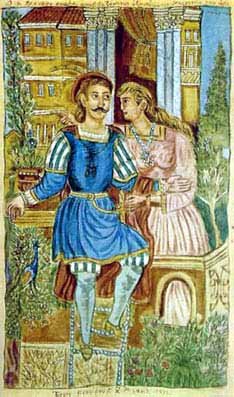
Life
Theofilos Hadjimichail- Kefalas was born in Vareia, Mytilene. The exact date of his birth is not known but it is presumed that he was born between 1867-1870. He was the first child of the family and he had 7 other siblings. His father was a shoemaker and his mother was the daughter of a religious icon painter. It was through his grandfather that Theofilos acquired his early painting skills and from a very young age he showed a strong inclination towards painting. He performed mediocre in school but his passion for painting had completely captured him and it was towards this end that he dedicated his entire life. He was self - taught and did not attend any school or had any other influence apart from his grandfather.
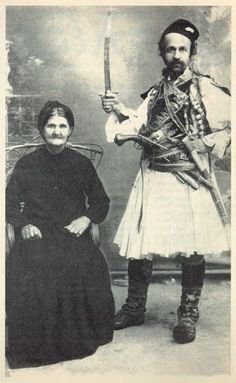
He moved from his hometown in Mytilene to Smyrna at the age of 18. There he worked for a short period of time in the Greek consulate. At about 1897 he moved to the city of Volos. For a short period of time he enlisted in the Greek army and participated in the Greco-Turkish war of 1897 without finding himself at the fields of battle though. Afterwards, he returned to Volos where he also settled for most of his life. There he worked in various different jobs and he also painted in many stores, coffeshouses, apartments and other buildings. Many of his works in Volos are still saved today. He stayed there for almost 30 years before finally returning to his hometown where he stayed for the rest of his life.
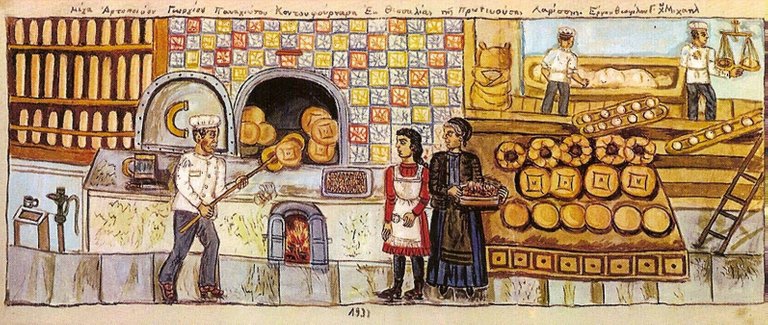
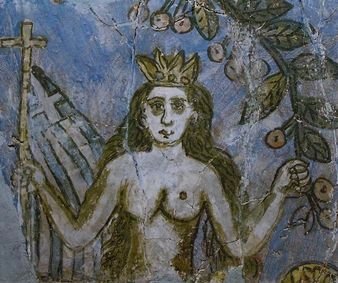

Theofilos found himself as the object of ridicule throughout his life. His custom of wearing the traditional costume of fustanella, sparked laughter and various other responses whenever he was amongst others. In a notable incident in Volos, while Theofilos was up in a ladder working on one of his paintings, someone pushed him over and made fun of that afterwards. It is said that this incident is what prompted him to return in Mytilene, his home island in 1927.
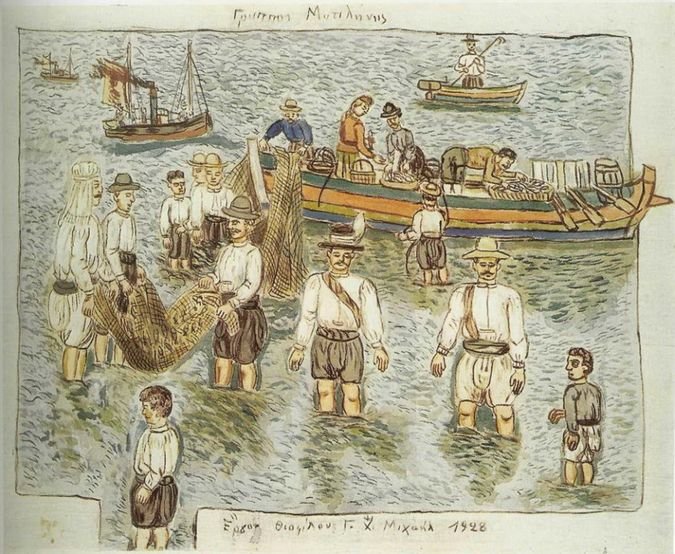
While in Mytilene, Theofilos continued to endure teasings and harrasments from others. He continued producing murals, frescos and other paintings to make ends meet. Similar to them in Volos, many of his works are still found today in bakery shops, houses and other buildings although unfortunately, due to natural decay, many of his originals are lost. Back in the day, to see Theofilos painting randomnly on a wall was a common spectacle in Mytilene and people would often hire him to decorate their houses as well paint their portraits. He would often receive as payment simply a plate of food or a small honorary fee for his work. He remained poor throughout his life.

Theofilos's work remained unrecognized throughout his life. However, while in Mytilene, he met with the highly regarded art critic Stratis Eleftheriadis. Eleftheriadis was also from Mytilene and was very much impressed by Theofilos's simple and unique style. He was the one who promoted his work and eventually helped in raising funds who the construction of the Theofilos folklore art museum in Theofilos's hometown in Vareia. A second museum dedicated to Theofilos, is located in Anakasia, Volos. This museum is decorated by many of his original works and it is also known as ''Oikia Kontou'' ( house of Kontos) from the name of the original owner of the house.
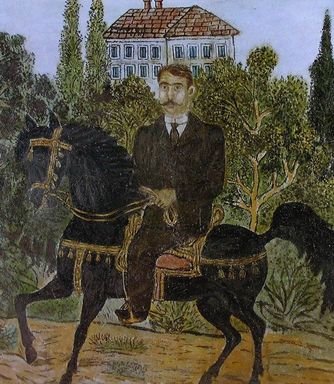
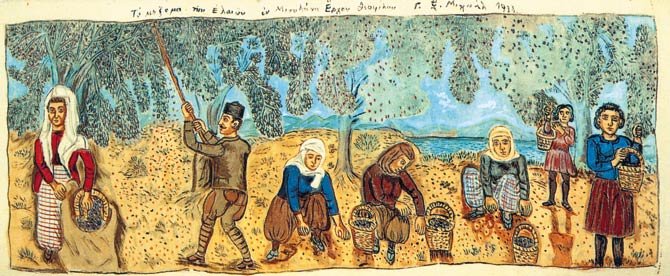
Theofilos died in March, 1934 in the eve of the feast of the Annunciation. It is believed that his death was probably caused by food poisoning.

Legacy
Theofilos's works are notable for many reasons. He drew inspiration from themes such as Greek mythology, legends and traditions of Greece, history, both ancient and contemporary and also painted sceneries that he had ecountered through his life and portraits. The diversity of the themes of his work is something remarkable in Greek folklore art and painting in general.
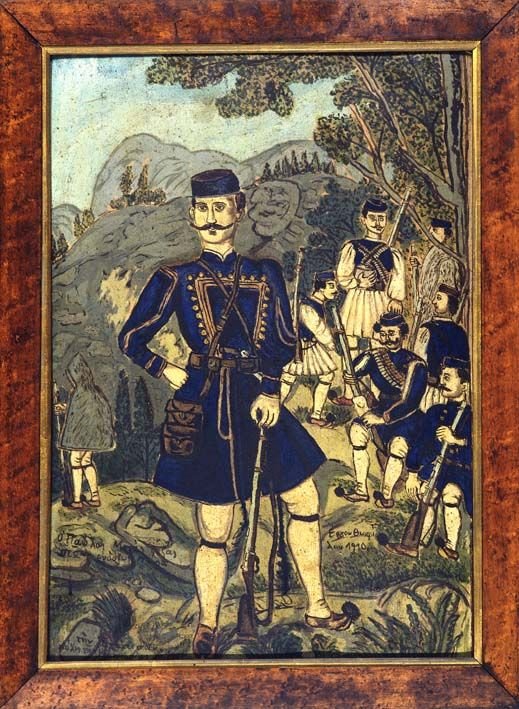
Giannis Tsarouxis, the famous Greek painter, had identified three periods in Theofilos's life. The first period, while he was in Thessaly, is notable by his attempts to draw realistically and his limited use of colour in his works. The second period, after his return in Mytilene, is characterized by his increasing choice of more vibrant colours and his more liberal painting style as opposed to his commitment to realism while back Volos. After his encounter with Eleftheriadis, Theofilos's style advanced more and reached its unique status and climax. The perfect balance between vibrant colours and softer tones was achieved and in this period we also find many of his masterpieces.
Today, Theofilos's works are highly acclaimed. While he died in poverty, his paintings today are estimated in the thousands of dollars. His ''Konstantinos Palaiologos'' was sold by Sotheby's for 115.000 dollars and many of his paintings range from 30.000-50.000 in price.

Odysseas Elytis, the winner of the 1979 Nobel prize in literature, had said of Theofilos:
Returning from the United States, in the June of 1961, I stopped for a few days in Paris and while I was strolling along the streets, the first thing I saw in the storefront of a book shop where I used to go, was a big poster on the exhibition of Theofilos, that has started this week in the museum of Louvre. My heart beated strong. Oh yes, finally! There is justice in this world!''

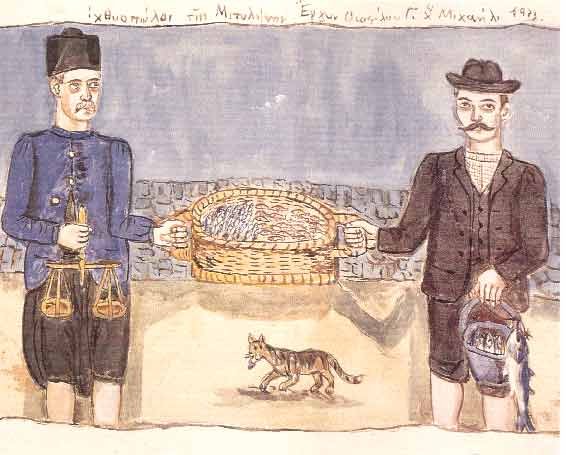
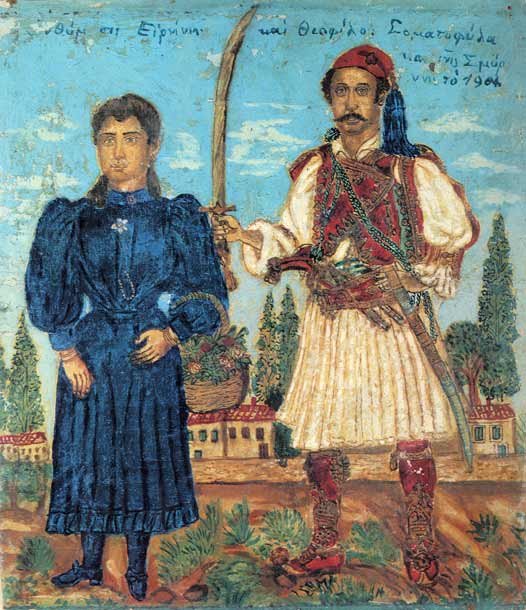
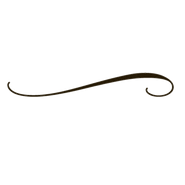
Sources of images in order of appearance:
- Erotokritos and Aretousa
- Theofilos with his mother
- Large bakery shop
- The mermaid
- Markos Botsaris
- Gryptos, Mytilene
- Adam and Eve
- Giannis Kontos
- The Olive harvest
- Theodoros Kolokotronis
- Pavlos Melas
- Konstantinos Pailaiologos
- Seashore
- Fishmongers in Mytilene
- Theofilos and Irene in Smyrna
Your presentation describes the subject comprehensively and your selection of paintings is exquisite :)
Σε ευχαριστώ πολύ eξάδελφε :)
Resteemed ;)
Very informative article, well done @theodorelib :)
I will visit your El Greco article too!
Thank you very much @katerinaramm :)
El Greco and Theofilos are my two favourite painters and along with Giannis Tsarouhis they are some of the best Greek painters in my opinion. I will dedicate a future post to Giannis Tsarouhis too, I don't know much about his life and work so it will be a chance for me to learn more about this also great painter and also share what I have found!
Καλημέρα φιλέ!! Φοβερή δημοσίευση!
Καλημέρα Νίκο! Σε ευχαριστώ πολύ φίλε :)
Πράγματι έκανες εξαιρετική δουλειά! Επειδή μου αρέσουν οι τέχνες και με ενδιαφέρει να συλλέγω οσο το δυνατον περισσοτερες πληροφορίες γύρω από αυτά τα θέματα, ομολογώ πως μου κίνησες το ενδιαφέρον!! 😊
Γενικά με ενδιαφέρει ανα καιρούς να μαθαίνω για τους μεγάλους καλλιτέχνες μας και να γνωρίζω τα έργα τους και την προσφορά τους. Ο Θεόφιλος είναι απο τους αγαπημένους μου οπότε θεώρησα καθήκον μου να γράψω 1-2 πράγματα γι' αυτόν!
Πολύ ωραία παρουσίαση . Μπράβο που γράφεις για τους μεγάλους μας !
Ευχαριστώ πολύ φίλε μου! Θεωρώ πολύ σωστό να γνωρίζουμε έστω και λίγα για τους μεγάλους καλλιτέχνες μας ώστε να αποτελούν συνεχώς έμπνευση και για το μέλλον. Το χρειαζόμαστε αυτό πιστεύω, ειδικά στις μέρες μας.
Αν μη τι άλλο. Επειδή όμως πληροφορίες τέτοιου τύπου εξυψώνουν το εθνικό φρόνημα , είναι παραλειπόμενες από την εκπαίδευση..
Δυστυχώς, η εκπαίδευση στην Ελλάδα είναι αποκλειστικά προσανατολισμένη στο πώς θα δημιουργεί καλούς και πειθήνιους υπαλλήλους. Όλα για να βρούμε μία δουλειά. Χώρος για λέξεις όπως αξία, πνεύμα, ευθήνη και χρέος έχουν εκλείψει εδώ και καιρό. Αλίμονο αν ο πραγματικός σκοπός της εκπαίδευσης είναι μόνο αυτός, να αποτελεί το δεκανίκι της αγοράς εργασίας. Δεν είναι να απορεί κανείς για το πώς φτάσαμε εδώ.
Παγκοσμιοποίηση λέγεται...
Πολύ αναλυτική παρουσιάση και πάλι! Αν δεν κάνω λάθος το πιο διάσημο έργο του πρέπει να είναι ο Ερωτόκριτος και η Αρετούσα!
Πολύ σωστά, και εγώ αυτό νομίζω πώς πρέπει να είναι το πιο γνωστό έργο του. Προσωπικά τον θεωρώ μαζί με τον Θεοτοκόπουλο τους μεγαλύτερους Έλληνες ζωγράφους! Διαφορετικές ζωές και τεχνοτροπίες αλλά και οι δύο νομίζω πώς εκφράζουν την Ελλάδα της εποχής τους με τρόπο μοναδικό.
Ναι η αλήθεια είναι οτι η τεχνοτροπία τους και το στυλ τους στην ζωγραφική είναι διαφορετικό αλλά είναι ακριβώς αυτό που λες εκφράζουν την Ελλάδα μοναδικά!